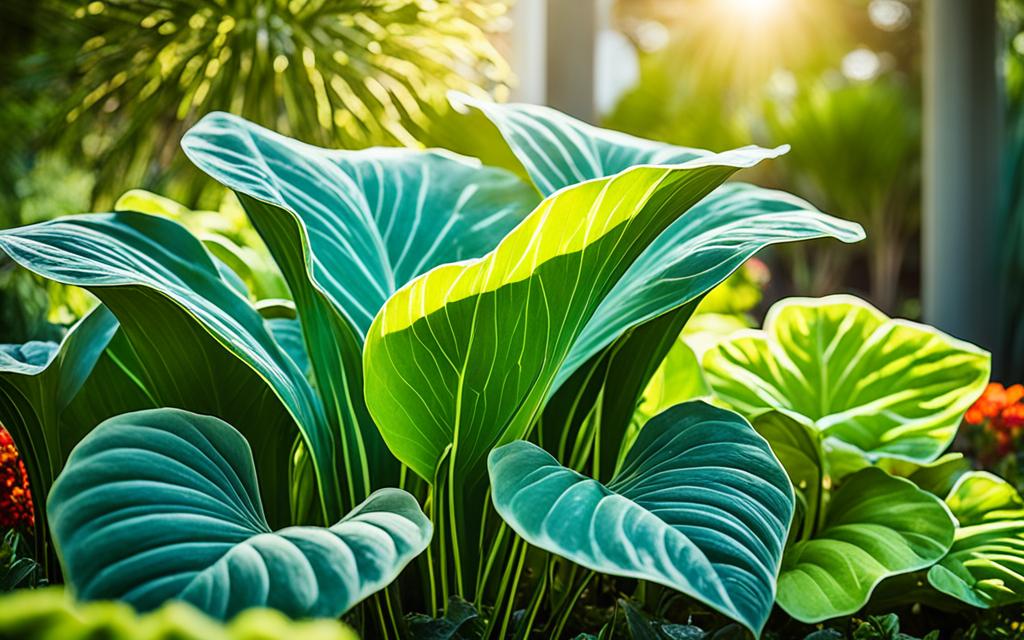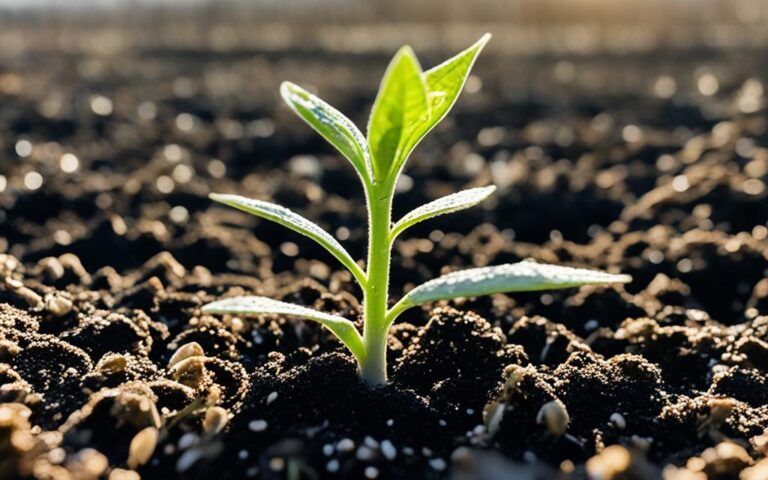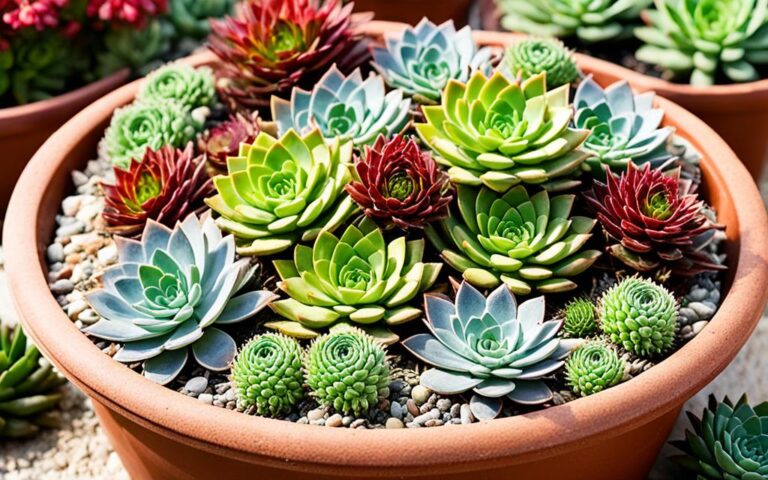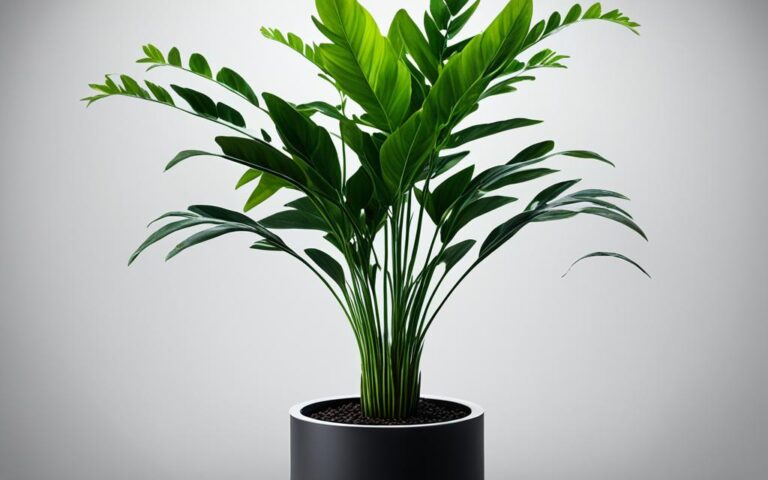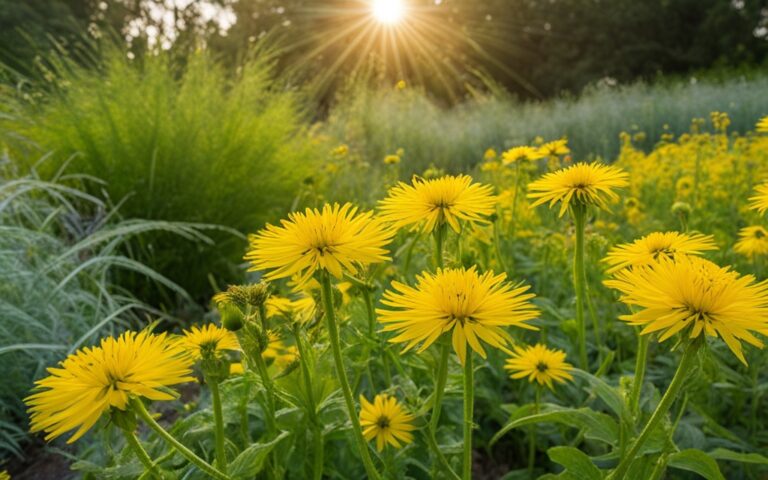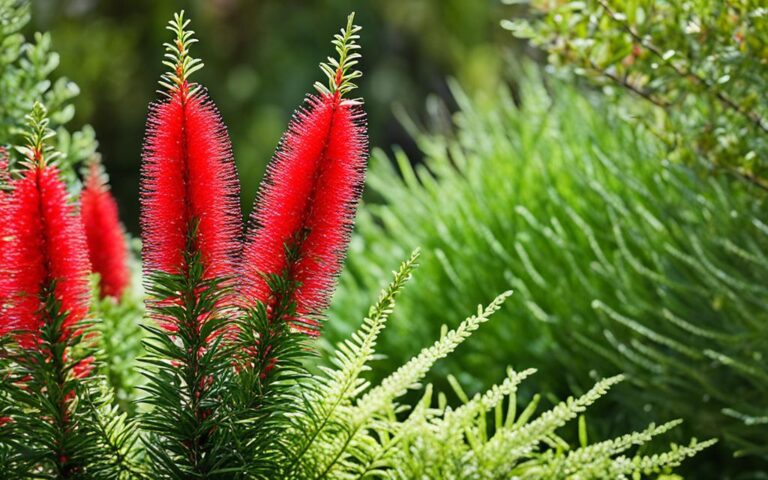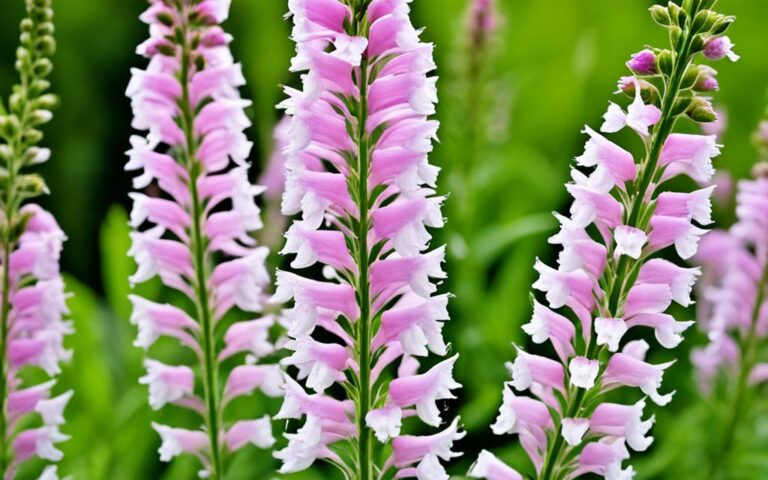Elephant Ears Plant: Growing Guide for Your Garden
Elephant ears plants bring bold foliage to your garden. Their huge, heart-shaped leaves come in many colors like black, purple, green, and yellow. Some leaves can be over three feet long on plants that grow taller than six feet.
The stems also show off vibrant colors. New hybrids from Alocasia, Colocasia, and Xanthosoma species offer many choices in colors, sizes, and habits. These tropical perennials are known for their large leaves. They belong to the Colocasia, Alocasia, and Xanthosoma genus. All elephant ears share similar growing conditions, despite being from different parts of the world.
Key Takeaways
- Elephant ears can reach a mature size of 3–6 feet tall and wide.
- Elephant ears are native to tropical regions around the world.
- They thrive in warm, humid conditions and require acidic, moist soil.
- Elephant ears come in a variety of colors, shapes, and sizes.
- Proper care and maintenance are essential for healthy elephant ear plants.
Introduction to Elephant Ears Plant
Elephant ears plants are part of the tropical perennial family. They are loved for their large, dramatic leaves that can reach up to 6 feet tall and 5 feet wide. These plants are a hit in gardens, landscapes, and botanical gardens for their striking leaves. They come in colors like black, purple, green, chartreuse, and yellow.
These plants are not just pretty; they have unique stems and flowers that add to their exotic look. They also serve as food crops in many places, with the corms used to make dishes like poi.
Elephant ears thrive in warm, humid places and are versatile in garden designs. They are a favorite among gardeners and landscape architects. They add a dramatic touch or provide shade in gardens.
| Elephant Ears Plant Characteristics | Details |
|---|---|
| Leaf Size | Up to 6 feet tall and 5 feet wide |
| Leaf Shape | Large, heart-shaped |
| Leaf Color | Black, purple, green, chartreuse, yellow |
| Plant Height | Varies by species, typically 3-5 feet |
| Cultivars | Over 200 varieties, including ‘Black Coral’, ‘Blue Hawaii’, ‘Coffee Cups’, and more |
| Growing Conditions | Warm, humid, moist soil |
“Elephant ears plants are a bold, tropical addition to any garden, adding a touch of the exotic with their large, dramatic foliage.”
Common Species and Varieties
The elephant ears plant family is diverse, with many species and cultivars. Each one has its own unique look. From the big leaves of Colocasia to the eye-catching patterns of Alocasia, there’s a wide range for gardeners and plant lovers.
Colocasia Varieties
Colocasia is famous for its variety of elephant ears. ‘Thailand Giant’ has leaves up to 5 feet long. ‘Illustris’ has dark green leaves with bright green veins. ‘Black Magic’ is a top choice for its black color.
Other types like ‘Blue Hawaii’, ‘Mojito’, and ‘Coffee Cups’ have interesting colors and shapes.
Alocasia Varieties
Alocasia includes the ‘A. x amazonica’, a hybrid with deep green leaves and white veins. ‘A. zebrina’ has zebra-striped stems, adding drama to gardens.
Xanthosoma Varieties
‘Lime Zinger’ from Xanthosoma has huge, lime-green leaves shaped like arrows. It loves warm weather and can handle both shade and sun.
| Species | Variety | Leaf Size | Leaf Color | Notable Features |
|---|---|---|---|---|
| Colocasia | Thailand Giant | Up to 5 feet | Green | Massive leaves |
| Colocasia | Illustris | Varies | Dark green, almost black with green veins | Striking leaf color |
| Colocasia | Black Magic | Varies | Dark, blackish-purple | One of the best black cultivars |
| Alocasia | x amazonica | Varies | Deep green with white veins | Amazonian hybrid |
| Alocasia | zebrina | Varies | Green | Zebra-striped stems |
| Xanthosoma | Lime Zinger | Varies | Chartreuse to lime-green | Vibrant, arrow-shaped leaves |
“Over the past 20 years, there has been a significant increase in the colors, shapes, and sizes of garden-worthy elephant ears, thanks to breeders like Hawaii’s Dr. John Cho and plant explorers like Alan Galloway.”
Anatomy of the Elephant Ears Plant
Elephant ears plants are known for their big, striking leaves, not their flowers. These leaves can be as long as 4-6 feet and wide, showing off colors like deep purple, black, green, chartreuse, and yellow. They are shaped like hearts or arrows, with some having wavy or ruffled edges.
The stems of these plants are also colorful, going from green to purple or red. They don’t bloom much when kept indoors or in gardens. But, they do produce small flowers in the right tropical setting.
Leaf Description
- Leaf size can vary, from a few inches to several feet wide, based on the species and growing conditions.
- Leaf colors range from deep green to various shades of purple, depending on the variety and environment.
- The leaf shape is usually heart-shaped or arrow-shaped, with some having wavy, ruffled, or cupped edges.
Stem and Flower Characteristics
The stems of elephant ears plants are colorful, going from green to purple or red. They don’t bloom much indoors or in gardens. But, they do produce small, hidden flowers in the right tropical conditions.
| Plant Characteristic | Description |
|---|---|
| Stem Color | Green, purple, or red |
| Flower Production | Small, hidden flowers in tropical conditions |
“Elephant ears can grow up to six feet tall with leaves stretching to the size of an arm.”
Ideal Growing Conditions
Elephant ears love warm, humid places that match their needs for light, temperature, and soil. These plants do best when they get the right conditions to grow.
Lighting: These plants like partial shade to full sun. Darker leaves need more sun to stay colorful. They can handle 3 to 6 hours of indirect sunlight a day, fitting into many gardens.
Temperature: The best temperature for elephant ears is about 70°F (21°C) in the day and 60°F (15°C) at night. They need a steady, warm spot, with soil at least 65°F (18°C) for growth.
Humidity: Being wetland plants, elephant ears do well in humid places. Indoor plants might need misting or a humidifier to keep moist.
| Growing Condition | Optimal Range |
|---|---|
| Light Requirements | 3-6 hours of indirect sunlight per day |
| Temperature | 70°F (21°C) during the day, 60°F (15°C) at night |
| Soil Temperature | Minimum 65°F (18°C) |
| Humidity | High, with regular misting for indoor plants |
| Soil Type | Rich, well-drained, slightly acidic (pH 5.5-7.0) |
| Watering | Consistently moist, but not soggy |
Soil: Elephant ears like rich, well-drained soil that’s a bit acidic, with a pH of 5.5 to 7.0. They do well in soil rich in organic matter, which keeps moisture and nutrients in.
Watering: These plants need soil that’s always moist but not too wet. They can handle up to 6 inches of water, but do best with consistently damp soil.
“Elephant ears are versatile plants that can add a tropical flair to any garden, from shady corners to sunny borders.”
Propagation Methods
Elephant ears are a hit in gardens for their unique look and interesting growth. They’re easy to spread through different ways. This lets gardeners grow more plants or share them with friends.
Dividing Tubers
Dividing the tubers is a top way to grow more elephant ears. After the growing season ends, dig up the tubers, let them dry, and split them. Make sure each piece has a growth node. Then, plant these pieces in spring when the soil is warm for best results.
Growing from Seed
Starting elephant ears from seed is possible but tricky. Most popular types are special varieties. Seeds might not grow into plants like the original, and starting them can be hard. Dividing the tubers is a better choice because it makes new plants just like the original.
Choosing how to grow elephant ears depends on what the gardener likes and needs. Knowing how to spread these plants helps gardeners keep and grow their collections.
Care and Maintenance
Caring for elephant ears plants means regular upkeep to keep them healthy. It’s important to prune and manage pests well. These plants look lush and tropical with the right care.
Pruning and Training
When pruning elephant ears, cut off any yellowing, dying, or drooping leaves. Remove them at the base of the stem. This encourages new, healthy leaves to grow. Proper pruning keeps the plant looking good and stops diseases.
Pests and Diseases
Elephant ears face many pests like aphids, mealybugs, and spider mites. These pests harm the leaves and stems. They can also get fungal diseases like leaf blight and root rot. It’s key to watch for pests and diseases and treat them fast to keep your plants healthy.
- Aphids can be controlled with horticultural soap or neem oil
- Mealybugs and spider mites can be managed by wiping down leaves with a damp cloth
- Leaf blight can be prevented by improving drainage and removing affected leaves
- Root rot can be addressed by adjusting watering habits and improving soil aeration
| Pest/Disease | Symptoms | Treatment |
|---|---|---|
| Aphids | Leaves with sticky residue, stunted growth | Horticultural soap, neem oil |
| Mealybugs | White, cottony masses on leaves and stems | Wipe leaves with damp cloth |
| Spider Mites | Stippling, webbing on leaves | Wipe leaves with damp cloth |
| Leaf Blight | Brown or black spots on leaves | Remove affected leaves, improve drainage |
| Root Rot | Wilting, yellowing leaves, soft, brown roots | Adjust watering, improve soil aeration |
By being vigilant and treating pests and diseases quickly, you can keep your elephant ears healthy and looking great.
Fertilizing Your Elephant Ears Plant
Elephant ears need regular feeding to grow well and have lots of leaves. Use a balanced, water-soluble fertilizer every two to four weeks in spring and summer. This helps your plant do its best.
Choose a fertilizer with nitrogen (N), phosphorus (P), and potassium (K), plus important micronutrients. For hardy elephant ears, a mix of 10-6-4 N-P-K is best. It gives your plant the nutrients it needs for big leaves, strong roots, and good health.
Using a 20-20-20 liquid fertilizer at half-strength monthly helps your elephant ears grow well and bloom. Phosphorus is key for flowers, so switch to a higher phosphorus fertilizer when it’s time to bloom.
Synthetic fertilizers work fast, while organic ones feed the soil and plant slowly. Change your fertilizer routine as your plant grows. Use less nitrogen and more bloom-boosting fertilizers when it’s ready to flower.
Don’t over-fertilize, or your plant might get yellow or brown leaves, or even wilt. If this happens, clean off any extra fertilizer, water the soil, and wait for your plant to recover. You might need to cut off damaged parts.
Slow-release fertilizers give your elephant ears steady nutrients without overdoing it. They help your plant grow steadily, like a marathon runner.
Benefits of Growing Elephant Ears Plant
Growing elephant ears plants has many perks for gardeners and homeowners. Their big, eye-catching leaves make them perfect for being the main attraction in gardens. They love wet conditions, making them ideal for water gardens, soggy spots, or container plantings.
These plants stand out with their large leaves and unique shapes. They look great with other tropical plants like bananas, cannas, and crinums. Plus, you can keep them indoors or move them outside when it’s warm. This makes them versatile for gardeners in different climates.
- Dramatic foliage adds a tropical, tropical look to gardens
- Thrives in water gardens and container plant settings
- Offers visual interest when paired with other tropical plants
- Versatile for indoor and outdoor use
“Elephant ears are a show-stopping addition to any garden, bringing a lush, dramatic foliage that instantly transports you to a tropical oasis.”
Elephant ears plants are a bold and adaptable choice for gardeners wanting a striking, tropical look. They’re perfect for outdoor spaces or bringing the beauty of nature inside.
Elephant Ears Plant: Growing Guide for Your Garden
Elephant ears are easy to grow but need special care to thrive. This guide gives you all the key info to grow these tropical plants in your garden. It covers everything from picking the right varieties to overwintering them.
It’s perfect for both experienced and new gardeners. With this guide, you’ll know how to grow beautiful elephant ears that will make your garden stand out.
Planting Instructions
- The soil temperature should reach 65ºF before planting elephant ear tubers.
- Elephant ears need at least three feet of space for proper growth.
- Three to four times the size of the tuber is the recommended size for the planting hole.
- It can take two to eight weeks before the first signs of sprouting appear.
Care Tips
- Elephant ears should receive consistent moisture throughout the summer.
- Apply liquid fertilizer every two to three weeks for optimal growth.
- Elephant ears need rich soil that is moist but well-drained.
- Elephant ears can tolerate variable moisture conditions, but dark-leaved types will suffer if overwatered and can stay dry for several days.
| Characteristic | Measurement |
|---|---|
| Elephant’s ear plant height range | 1 to 8 feet |
| Elephant’s ear plant width range | 1 to 6 feet |
| Ideal growing zones for elephant’s ear | 10, 11 |
| Recommended pH range for soil | between 5.5 to 6.5 |
| Optimal daytime temperatures | between 70°F and 85°F |
| Desired humidity level | above 50 percent |
| Typical lifespan of healthy elephant’s ear plants | about eight years |
Follow these growing guide, care tips, and planting instructions to grow beautiful elephant ears. They’ll add a touch of the tropics to your garden.
Overwintering Elephant Ears Plant
As the weather gets colder, it’s time to protect your elephant ears plants for winter. These plants can’t handle freezing temperatures. So, it’s important to overwinter them to make sure they come back strong next year.
In-Ground Overwintering
If you live in USDA Hardiness Zones 7b-10, you can keep your elephant ears in the ground. Just add a thick layer of mulch to keep them warm. After the first frost, cut the leaves back, leaving a bit above the soil. This protects the tubers from cold snaps.
Storing Tubers
In colder areas, you’ll need to dig up the elephant ear tubers. Clean them off and store them in a cool, dry spot like a basement or garage. Wait until spring, when it’s safe to plant them again. The soil should be at least 65°F before you replant.
Storing the tubers right is crucial for your elephant ears to thrive. Always wear gloves when handling them because they can irritate your skin.
By taking these steps, you can keep your elephant ears looking great every year. No matter where you live, you can enjoy their beautiful leaves.
Container Gardening with Elephant Ears Plant
Elephant ears, or Colocasia, are great for container plants. They add a big, dramatic look to small outdoor areas. Make sure your pot is at least 18 inches wide to fit the plant’s roots. Use a pot with lots of drainage holes and fill it with a good potting mix that’s rich in nutrients.
These plants need more water because the soil dries out fast in containers. It’s important to keep the soil moist but not too wet. With the right pot and care, elephant ears can be a beautiful addition to your patio, deck, or balcony.
- Elephant Ears need a container that’s at least 18 inches wide and deep
- Use a potting mix that drains well and add organic matter to it
- These plants should be watered more often
- Keep the soil consistently moist but don’t let it get too wet
By following these tips, you can grow beautiful elephant ears in container plants. They’ll add a tropical touch to even the smallest outdoor areas.
Landscaping with Elephant Ears Plant
Elephant ears plants add a bold, tropical look to any landscape. They have giant, lush leaves that can be the main attraction or blend into different garden styles.
Companion Plants
Elephant ears look great with other tropical plants for a lush look. Some good friends for them are:
- Bananas
- Cannas
- Crinums
- Caladiums
- Gingers
The big leaves of elephant ears contrast well with the smaller leaves of these plants. This makes for a beautiful landscape.
Design Ideas
Elephant ears can be used in many ways to improve your landscape. In water gardens or wet spots, they grow well in the water or in containers. They add a lush, tropical garden feel.
In dry gardens, they bring an exotic look with their big leaves and smaller plants. For container gardens, they’re perfect, showing off in a water garden or landscaping setup. They do well in full sun or partial shade, fitting many design ideas.
Elephant ears are great for adding exotic and lush vibes to any landscaping project. They work well in tropical gardens or traditional outdoor areas.
Troubleshooting Common Issues
Elephant ears are tough plants but can face pests, diseases, and environmental challenges. By quickly fixing these problems, gardeners can keep their elephant ears healthy and looking great.
Pests and Diseases
Aphids, mealybugs, and spider mites often bother elephant ears. Use horticultural soap or insecticidal sprays to fight them. Fungal diseases like leaf blight and root rot come from too much water or bad drainage. Remove sick leaves or stems and improve the soil to fix these problems.
Environmental Stresses
Extreme heat, cold, or drought can harm elephant ears, causing them to look bad or grow poorly. Look out for pale, bent, or droopy leaves and brown spots on roots or leaves. Keep an eye on your plants and adjust their environment to help them recover.
| Issue | Symptoms | Remedy |
|---|---|---|
| Fungal Leaf Blight | Brown or black spots on leaves | Apply copper fungicide |
| Pythium Rot | Wilting, collapsing stems | Improve drainage, reduce watering |
| Nutrient Deficiency | Stunted growth, pale leaves | Apply balanced 10-10-10 fertilizer |
| Spider Mite Infestation | Deformed, discolored leaves | Treat with neem oil or rubbing alcohol |
| Drought Stress | Wilting, collapsing stems | Water immediately, maintain regular irrigation |
| Root Rot | Brown spots on roots | Allow soil to dry out between waterings |
Quickly dealing with pests, diseases, and environmental issues keeps elephant ears healthy and bright all season.
Conclusion
Elephant ears are a standout in any garden, bringing bold, tropical foliage that grabs attention. They come in various sizes, colors, and growth patterns, fitting almost any garden design. These plants love warm, humid weather and need regular watering and rich soil to flourish. Despite their care needs, elephant ears are pretty easy to look after. They can grow in the ground, pots, or even indoors.
This guide helps gardeners make the most of these unique tropical plants. Whether you want them as a centerpiece, a lush background, or a calming feature in your garden design, elephant ears will impress. Their eye-catching look makes them a top choice for garden lovers aiming to create a tropical paradise.
In summary, elephant ears plant bring a slice of the tropics to your garden, offering joy for years to come. By meeting their needs and adding them to your garden, you can transform your outdoor area into a beautiful, peaceful space.
